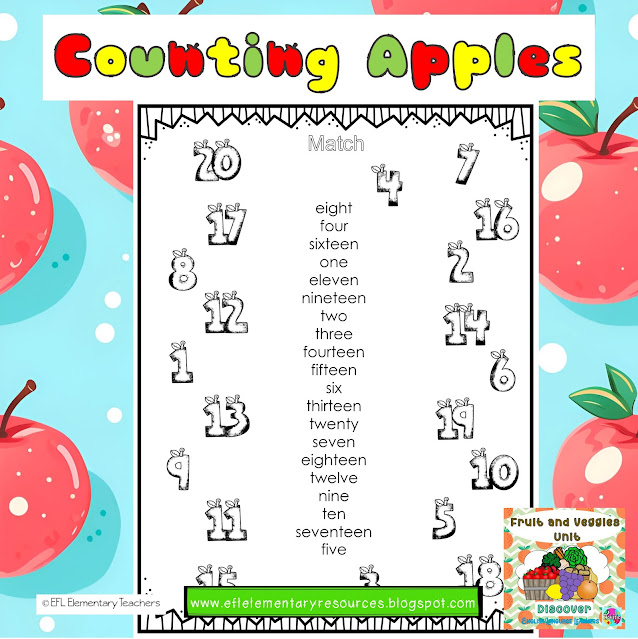This resource (Counting Apples 1–20 for Elementary ELLs — Printable Number & Fruit Flashcards + Games) is included in The Fruit and Vegetables level 1 for Elementary ELLS.LINK:https://www.teacherspayteachers.com/Product/Fruit-and-Vegetables-level-1-for-Elementary-ELLS-12275711
These interactive set of printable flashcards are especially effective because they combine math
skills with English language development.
Count quantities visually (apples in a basket). Students can use full sentences like "There are ten apples" or
"I see five apples," supporting sentence structure, pronunciation,
and fluency.
Hold up a flashcard and ask, “How many apples are in the basket?”
Students: There are thirteen!
The small cards work for centers/general classroom. Let students sort the flashcards in order from 1 to 20—or backwards!
Apple Basket Bingo. Play using the small cards. Give each student a bingo board
worksheet. There are 4 boards. They can write 5 numbers on each one.
Teacher: Let’s play with board 1.
Call out numbers using the small
cards. If they have that number of apples on a card, they cover it. The boards
can be used several times. This is a
game will a focus on listening and number identification.
Worksheets are
useful for repetition through written tasks helps students remember number
words and symbols.
This is a read and color worksheet. Students count the apples in a
basket and color the correct number. There is a cut out numeral worksheet to
glue on each basket. Great for reading, spelling, and fine-motor practice.
A Worksheets to match the correct numeral to the number word. Draw a line.
Write the number words worksheets.
A set of worksheets. First, dictate the color of each numbered apple.
Then, students will complete the color of each apple.
Number words appear in many subjects—math problems, science
instructions, classroom directions—so mastering them improves academic success
across the board.
Count and Match Game
Spread out numeral cards (1–20) and have students match them to the correct
basket of apples.
Print three sets—one with numbers
(1–20), one with apple baskets, one with words. Students take turns finding a
match. This will focus on number recognition and matching quantities.
The board game is great for early finishers, math centers, or small group work. It's low-prep, just print and cut. It comes with 4 paths to choose from. Prepare the apple game markers. Players take turns rolling the die and moving their marker the correct number of spaces along their path. When landing on a space, the player says the number word out loud (e.g., “Seventeen!”). The first player to reach the end of their path is the winner.
A 3-wheel template that matches the quantity of apples, the numeral,
and the number word is a highly interactive tool that supports visual, tactile,
and linguistic learning. It will strengthen Number-Word Recognition by connecting
numerals (e.g., “8”) with number words (“eight”) and visual quantities.
Cut out the three circular wheels. Layer the wheels in order. Fasten them together in the center using a
brass fastener.
Students will spin the wheels to mix
and match until all three parts show the correct match. Say the full match out
loud: “I see six apples. The number is 6. The word is six.” It's a fun review — spin to match all three.

Here’s why you’ll love visiting my other blog EFL Preschool Teachers: https://eflpreschoolteachers.blogspot.com/
✅ Fun and Interactive Activities: Keep your students excited with
hands-on games, and crafts.
👉 Don’t miss out—visit today and bring your lessons to life! 🚀🎈













































